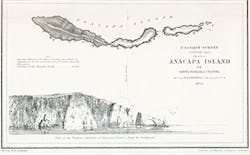ONE OF MY MOST TREASURED POSSESSIONS is an 1854 map of Anacapa Island, an 11-mile islet off of the coast of California. The map’s intricate crosshatches are poetic and precise. But beyond beauty, two things make it meaningful to me. The first is a flock of sea birds in flight near the island’s cliffs, a non-essential flourish that I learned the government draftsman was fired for. And the second is that the young man signed it J. A. Whistler, a name that is today associated with his striking works of art.
I like to imagine Whistler’s map guiding ships that navigated California’s coastal waters in the late 1800s. But I also like to reflect on the way that its etched details oriented the artist philosophically, and perhaps directed the path of his life.
We need maps. We rely on them to orient us, to show us where we are in relation to others, and to guide us from point A to point B, perhaps by way of Z. Maps inform our decision-making and often serve as an operational compass.
I spent the first week of October at the Water-Smart Conference in Las Vegas, NV. One of the professional tracks that I found especially compelling examined issues at the water-energy nexus. By evaluating the points of intersection between water and energy infrastructure, speakers revealed an array of opportunities for improved efficiency.
In one session, Juliet Ohemeng-Ntiamoah of Tennessee Tech University discussed the underutilized potential energy in wastewater (which is 10 times more than the energy used to treat it) in the form of thermal energy, nutrients, and biogas. In another, Prakash Rao of the Lawrence Berkeley Lab presented efficiency resources for water utilities; from building strategies and plant configurations, to effective training methods, data management plans, and DOE guidelines.
The most resonant take-away from the conversations that I had during the week was the fact that consumers and utilities alike are looking for guidance when it comes to water conservation and reducing energy use. How do we get from here to there? The attendees I spoke with consistently expressed the need for a roadmap as we face global population growth and increasing water scarcity.
Consider this issue of Water Efficiency magazine your efficiency atlas. We’ve distilled a staggering amount of data and concepts within these pages in an effort to provide readers with a guide to emerging technologies and conservation strategies.
Our cover story outlines approaches for educating the public about metering technologies. In “AMI 101”, we present ways in which municipalities are successfully teaching customers about the benefits of this technology. From engagement strategies to communications plans and toolkits with collateral to share with end-users, the story provides actionable plans.
In “Membrane Innovations”, we explore varying levels of disinfection, from microfiltration and nanofiltration, to reverse osmosis. This primer is designed to support informed decision-making as municipalities determine which purification system is best suited to their specific location and water treatment needs.
As part of our efforts to outline concrete steps toward water conservation, we look closely at rehabilitation strategies for urban environments in “Pipeline First Aid,”. From pipe cleaning and root cutting to chemical grouting, liner options, and pipe bursting, the article suggests methods that are proven to save water, facilitate infrastructural repair, and increase operational efficiency.
In “Limiting Loss”, we look at how three utilities—San Antonio Water System, Miami-Dade County Water and Sewer Department, and DC Water—address the issue of water loss in different ways. In doing so, the article offers blueprints of three unique solutions.
A good map says: You are here. And it shows you not only the destination, but also guides you toward the best route to take. Our hope is that each article provides that directional guidance while inspiring active conservation.
What steps toward efficiency is your organization taking?
